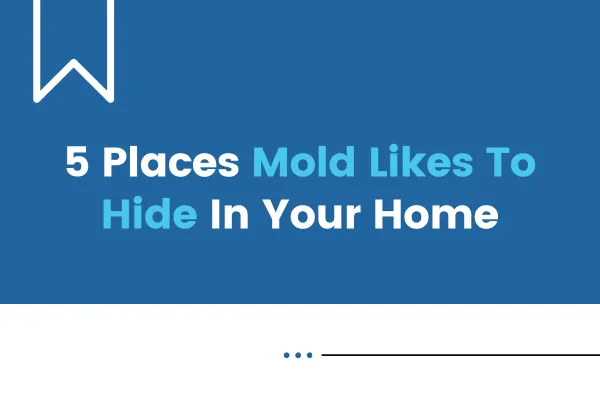
Top 5 Places Mold Loves to Hide (and How We Find It)
Mold doesn’t exactly ring the doorbell and say “Hey, I’m here!” It creeps, hides, and throws a party behind your walls while you’re just trying to binge Netflix in peace. If your kids are having respiratory problems, your allergies are acting up, or your walls smell like that gym sock from 2009, you might have a mold problem.
Let’s expose the places mold loves most...and what we do to kick it to the curb.
What is Mold, and Why Is It Harmful?
Mold is a type of fungus that thrives in damp, humid environments. Some types, like black mold (Stachybotrys chartarum), are more dangerous than others and can cause severe health problems.

Mold toxicity occurs when mold spores are inhaled, ingested, or come into contact with the skin. Prolonged exposure to mold can lead to serious health issues, especially for those with compromised immune systems or respiratory conditions.
Who Are We, And Why Should You Listen To Us?
We’re not just any mold crew.
We’re Kansas City’s go-to team when things get messy.

With 35+ years of experience, 100s of thousands of square feet of moldy drywall safely removed, crawlspaces rescued from mildew doom, and basements restored to breathable bliss, we’ve seen it all.
Our certified technicians don’t just clean up mold...we make sure it doesn’t come back. Period.
Top Places Mold Likes To Hide In Your Home (And How We Find It)
Here at Advanced Recovery of the Midwest, we see how the heat and humidity of summer causes rapid mold growth in homes with water damage. Even a small leak can cause mold growth over time... and when a hot water pipe breaks mold can begin growing in as little as 24 hours.
To help Kansas City homeowners protect their homes, here are 5 places that mold might be sneakily hiding in your home:
1. Behind Your Walls (Especially Near Plumbing)
Mold’s motto? “Moisture is money.” Anywhere there’s a slow leak, mold sees opportunity. Think behind your bathroom vanity, behind your fridge, or around your laundry room hookups.
Kansas City Tip: Our Midwest freeze-thaw cycles put pipes under stress. A teeny-tiny leak might not cause a flood, but it will invite mold.
The good news? We use moisture meters to find these leaks...or in some cases an exploratory cut into the drywall to see if there is mold behind on the framing.
2. Basements (Where Mold Throws Ragers)
Kansas City basements are infamous for being damp, dark, and the perfect stage for mold’s greatest hits. Between sump pump failures and foundation seepage, basements often become mold’s first stop.
We work with top-grade mold testing companies to take samples in your home which are evaluated in a mold lab to determine whether mold is present, and at what levels.
Pro Tip: We also check for high humidity levels and past water damage signs. Even if the water’s long gone, mold spores never forget. We track the spore patterns and find their source with lab-grade testing* and trained eyes.
3. Attics (Mold’s Summer Hideaway)
Kansas summers? Hot and humid. If your attic isn’t ventilated properly, it turns into a mold motel. Especially if your roof has a sneaky leak, or if bathroom exhaust fans vent into the attic instead of outside.
Sad Truth: If your attic insulation looks like a mildew sandwich, it’s time for a free mold inspection. We climb into every dusty corner (so you don’t have to) and will recommend air sampling to catch spores in the act.
4. HVAC Systems (Because Mold Loves to Travel in Style)
Your air ducts? First-class travel for mold spores. Once inside, they spread to every room like an uninvited guest at a house party.
Kansas City Insight: Older homes often have ductwork that’s never been cleaned. We partner with local Kansas City HVAC companies to perform full HVAC inspections and offer sanitizing treatments that don’t just remove mold...they sterilize your air system.
5. Under Flooring (Especially Laminate and Carpet)
If you’ve ever had a spill that wasn’t dried properly... (or worse, a Kansas thunderstorm flooded your floors) you could be walking over mold every day... causing those allergy symptoms that just won't go away. Mold loves to live under carpets, baseboards, and floating floors!
Our Secret Weapon: We use floor-lift sampling, infrared thermography, and even moisture meters to see under the flooring without tearing up your entire house.
When to Call a Professional
If you notice any of these mold symptoms or are concerned about potential mold in your house, it’s crucial to address the issue quickly. While small mold problems can often be handled with easy solutions, large-scale mold infestations—especially involving black mold—require professional remediation to ensure the mold is completely removed and your home is safe.
Conclusion
Mold growth in your home is not only damaging to your property but can also pose significant health risks. Knowing the signs of mold and addressing the problem early can help you avoid the dangers of mold toxicity and keep your home healthy and mold-free. If you suspect mold is present, don’t hesitate to call us. Your health and the well-being of your home depend on it!
